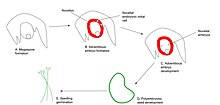
Back Nucela embriodisvolviĝo Esperanto Embrionía adventicia Spanish Embrioni nucellari Italian 珠心胚実生 Japanese Embrionia adventícia Portuguese Adventiv embrioniya Uzbek


Nucellar embryony (notated Nu+) is a form of seed reproduction that occurs in certain plant species, including many citrus varieties. Nucellar embryony is a type of apomixis, where eventually nucellar embryos from the nucellus tissue of the ovule are formed, independent of meiosis and sexual reproduction.[1] During the development of seeds in plants that possess this genetic trait, the nucellus tissue which surrounds the megagametophyte can produce nucellar cells, also termed initial cells. These additional embryos (polyembryony) are genetically identical to the parent plant, rendering them as clones. By contrast, zygotic seedlings are sexually produced and inherit genetic material from both parents. Most angiosperms reproduce sexually through double fertilization. Different from nucellar embryony, double fertilization occurs via the syngamy of sperm and egg cells, producing a triploid endosperm and a diploid zygotic embryo. In nucellar embryony, embryos are formed asexually from the nucellus tissue. Zygotic and nucellar embryos can occur in the same seed (monoembryony), and a zygotic embryo can divide to produce multiple embryos.[2] The nucellar embryonic initial cells form, divide, and expand. Once the zygotic embryo becomes dominant, the initial cells stop dividing and expanding. Following this stage, the zygotic embryo continues to develop and the initial cells continue to develop as well, forming nucellar embryos. The nucellar embryos generally end up outcompeting the zygotic embryo, rending the zygotic embryo dormant. The polyembryonic seed is then formed by the many adventitious embryos within the ovule[3] (to picture this process, refer to Figure 1). The nucellar embryos produced via apomixis inherit its mother's genetics, making them desirable for citrus propagation, research, and breeding.[4]
- ^ a b Zhang, Siqi; Liang, Mei; Wang, Nan; Xu, Qiang; Deng, Xiuxin; Chai, Lijun (March 2018). "Reproduction in woody perennial Citrus: an update on nucellar embryony and self-incompatibility". Plant Reproduction. 31 (1): 43–57. doi:10.1007/s00497-018-0327-4. ISSN 2194-7953. PMID 29457194. S2CID 254022638.
- ^ Aleza, P.; Juárez, J.; Ollitrault, P.; Navarro, L. (2010). "Polyembryony in non-apomictic citrus genotypes". Annals of Botany. 106 (4): 533–545. doi:10.1093/aob/mcq148. PMC 2944972. PMID 20675656.
- ^ Koltunow, A. M. (1993-10-01). "Apomixis: Embryo Sacs and Embryos Formed without Meiosis or Fertilization in Ovules". The Plant Cell. 5 (10): 1425–1437. doi:10.1105/tpc.5.10.1425. ISSN 1040-4651. PMC 160373. PMID 12271038.
- ^ Spillane, C.; Steimer, A.; Grossniklaus, U. (2001-12-01). "Apomixis in agriculture: the quest for clonal seeds". Sexual Plant Reproduction. 14 (4): 179–187. doi:10.1007/s00497-001-0117-1. ISSN 1432-2145. PMID 24573424. S2CID 23996256.